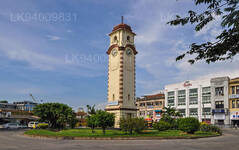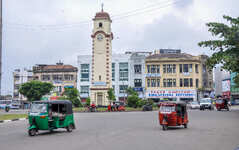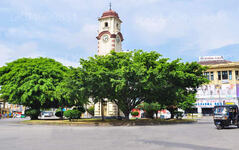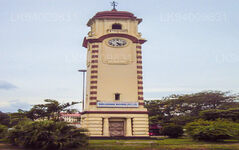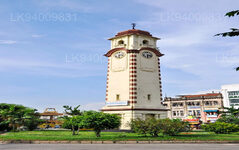
/páginas/transferências
Colombo, a capital do Sri Lanka, é uma cidade dinâmica que mistura tradição e modernidade. Ela exibe arquitetura colonial, mercados animados e templos budistas serenos. Com uma gastronomia diversificada, um horizonte crescente e belas praias, é um centro vibrante de negócios, cultura e turismo, oferecendo uma porta de entrada para explorar as maravilhas do Sri Lanka.
Khan Clock Tower
As you enter the City of Colombo from the Colombo Harbour, the first thing you would encounter is the sprawling Pettah Market. Filled with all the bright colors, noise, bustle, and pungent smells; the market is the biggest and busiest market on the island. All the goods that are brought in from the ships pass through the market, and as a result, you can find almost anything and everything here.
Guarding the entrance to this industrious zone is a century-old clock tower known as the Khan Clock Tower. The tower was built in the early 20th century by a Parsi family of the name Khan.
The Parsis were essentially Persians who had migrated to India around the 7th century AD for fear of religious discrimination when the Arabs invaded what is now Iran. Many settled in Gujarat. Their older roots segregated them from the modern Zoroastrian Indian community of Iranis who only arrived in the 19th and 20th century. The Parsis were often traders and had business interests in the nearby communities.
The Khan family were a particularly illustrious Parsi family who had many trade interests in Ceylon, as Sri Lanka was then called. They owned many large businesses, including the Colombo Oil Mills, which was quite famous at the time for producing many varieties of high quality oil.
In 1878, the patriarch of the family – Framjee Bhikhajee Khan – passed away leaving his two sons to take over the family’s trade. They successfully grew their businesses achieving fame and fortune over the next several decades. But they never forgot their father, who taught them so much and made them who they were.
In the year of 1923, they built a clock tower and fountain in his memory, close to where he loved to work. On the base of the clocktower an inscribed plate was attached. It said: "This clock tower and fountain was erected to the memory of Framjee Bhikhajee Khan by his sons Bhikhajee and Munchershaw Framjee Khan as a token of affectionate gratitude and dedicated through the Municipal Council to the citizens of Colombo on the fourth day of January 1923, the 45th anniversary of his death.”
The four-story tall tower remains there to this day on a landscaped roundabout. The water fountain that’s attached to it has long stopped working. But clock tower continues to function. A rock solid memorial to the love and affection of family.
Sobre o Distrito de Colombo
Colombo é a maior cidade e capital comercial do Sri Lanka. Está localizada na costa oeste da ilha e adjacente a Sri Jayewardenepura Kotte, a capital do Sri Lanka. Colombo é uma cidade movimentada e vibrante, com uma mistura de vida moderna e edifícios e ruínas coloniais, e uma população de 647.100 habitantes. A Região Metropolitana de Colombo, definida pelos distritos de Colombo, Gampaha e Kalutara, tem uma população estimada de 5.648.000 habitantes e cobre uma área de 3.694,20 km². Colombo é uma cidade multiétnica e multicultural. É a cidade mais populosa do Sri Lanka, com 642.163 habitantes vivendo dentro dos limites da cidade. A população de Colombo é uma mistura de vários grupos étnicos, principalmente cingaleses, mouros e tâmeis. Há também pequenas comunidades de pessoas de origem chinesa, portuguesa, holandesa, malaia e indiana vivendo na cidade, bem como numerosos expatriados europeus. A grande maioria das empresas cingalesas tem sua sede em Colombo. Algumas das indústrias incluem produtos químicos, têxteis, vidro, cimento, artigos de couro, móveis e joias. No centro da cidade está localizado o segundo edifício mais alto do sul da Ásia: o World Trade Center.
Sobre o Distrito de Colombo
A Província Ocidental é a província mais densamente povoada do Sri Lanka. Abriga a capital legislativa, Sri Jayawardenepura Kotte, e Colombo, o centro administrativo e comercial do país. A Província Ocidental é dividida em três distritos principais: Colombo (642 km²), Gampaha (1.386,6 km²) e Kalutara (1.606 km²). Como centro econômico do Sri Lanka, todas as grandes corporações locais e internacionais estão presentes na cidade, assim como todos os grandes estilistas e varejistas de rua. Portanto, prepare-se para se deliciar com as compras na Província Ocidental. Com a maior população de todas as províncias, quase todas as principais instituições de ensino da ilha estão localizadas na Província Ocidental. As universidades da província incluem a Universidade de Colombo, a Universidade de Sri Jayewardenepura, a Universidade de Kelaniya, a Universidade Aberta do Sri Lanka, a Universidade Budista e Pali do Sri Lanka, a Universidade de Defesa General Sir John Kotelawala e a Universidade de Moratuwa. A província ocidental tem a maior quantidade de escolas do país, que inclui escolas nacionais, provinciais, privadas e internacionais.

